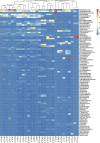Seasonal dynamics in leaf litter decomposing microbial communities in temperate forests: a whole-genome- sequencing-based study
- PMID: 39329142
- PMCID: PMC11426322
- DOI: 10.7717/peerj.17769
Seasonal dynamics in leaf litter decomposing microbial communities in temperate forests: a whole-genome- sequencing-based study
Abstract
Leaf litter decomposition, a crucial component of the global carbon cycle, relies on the pivotal role played by microorganisms. However, despite their ecological importance, leaf-litter-decomposing microorganism taxonomic and functional diversity needs additional study. This study explores the taxonomic composition, dynamics, and functional role of microbial communities that decompose leaf litter of forest-forming tree species in two ecologically unique regions of Europe. Twenty-nine microbial metagenomes isolated from the leaf litter of eight forest-forming species of woody plants were investigated by Illumina technology using read- and assembly-based approaches of sequences analysis. The taxonomic structure of the microbial community varies depending on the stage of litter decomposition; however, the community's core is formed by Pseudomonas, Sphingomonas, Stenotrophomonas, and Pedobacter genera of Bacteria and by Aureobasidium, Penicillium, Venturia genera of Fungi. A comparative analysis of the taxonomic structure and composition of the microbial communities revealed that in both regions, seasonal changes in structure take place; however, there is no clear pattern in its dynamics. Functional gene analysis of MAGs revealed numerous metabolic profiles associated with leaf litter degradation. This highlights the diverse metabolic capabilities of microbial communities and their implications for ecosystem processes, including the production of volatile organic compounds (VOCs) during organic matter decomposition. This study provides important advances in understanding of ecosystem processes and the carbon cycle, underscoring the need to unravel the intricacies of microbial communities within these contexts.
Keywords: Bacteria; Fungi; Leaf litter decomposition; Metagenome; Microbial communities; Temperate and boreal forests; Volatile organic compounds (VOCs).
©2024 Khomutovska et al.
Conflict of interest statement
The authors declare there are no competing interests.
Figures






Similar articles
-
Limited Effects of Variable-Retention Harvesting on Fungal Communities Decomposing Fine Roots in Coastal Temperate Rainforests.Appl Environ Microbiol. 2018 Jan 17;84(3):e02061-17. doi: 10.1128/AEM.02061-17. Print 2018 Feb 1. Appl Environ Microbiol. 2018. PMID: 29180362 Free PMC article.
-
Life in leaf litter: novel insights into community dynamics of bacteria and fungi during litter decomposition.Mol Ecol. 2016 Aug;25(16):4059-74. doi: 10.1111/mec.13739. Mol Ecol. 2016. PMID: 27357176
-
Bacterial succession on decomposing leaf litter exhibits a specific occurrence pattern of cellulolytic taxa and potential decomposers of fungal mycelia.FEMS Microbiol Ecol. 2016 Nov;92(11):fiw177. doi: 10.1093/femsec/fiw177. Epub 2016 Aug 18. FEMS Microbiol Ecol. 2016. PMID: 27543318
-
Role of phyllosphere fungi of forest trees in the development of decomposer fungal communities and decomposition processes of leaf litter.Can J Microbiol. 2006 Aug;52(8):701-16. doi: 10.1139/w06-023. Can J Microbiol. 2006. PMID: 16917528 Review.
-
Microbial activity and the dynamics of ecosystem processes in forest soils.Curr Opin Microbiol. 2017 Jun;37:128-134. doi: 10.1016/j.mib.2017.06.008. Epub 2017 Jul 6. Curr Opin Microbiol. 2017. PMID: 28689057 Review.
References
-
- Anderson MJ, Walsh DCI. PERMANOVA, ANOSIM, and the Mantel test in the face of heterogeneous dispersions: what null hypothesis are you testing? Ecological Monographs. 2013;83(4):557–574. doi: 10.1890/12-2010.1. - DOI
-
- Andrews S. FastQC: a quality control tool for high throughput sequence data. 2010. http://www.bioinformatics.babraham.ac.uk/projects/fastqc/ http://www.bioinformatics.babraham.ac.uk/projects/fastqc/
-
- Bani A, Pioli S, Ventura M, Panzacchi P, Borruso L, Tognetti R, Tonon G, Brusetti L. The role of microbial community in the decomposition of leaf litter and deadwood. Applied Soil Ecology. 2018;126:75–84. doi: 10.1016/j.apsoil.2018.02.017. - DOI
-
- Bardgett RD, Jones AC, Jones DL, Kemmitt SJ, Cook R, Hobbs P. Soil microbial community patterns related to the history and intensity of grazing in sub-montane ecosystems. Soil Biology and Biochemistry. 2008;40(1):2543–2551. doi: 10.1016/S0038-0717(01)00086-4. - DOI
MeSH terms
LinkOut - more resources
Full Text Sources

